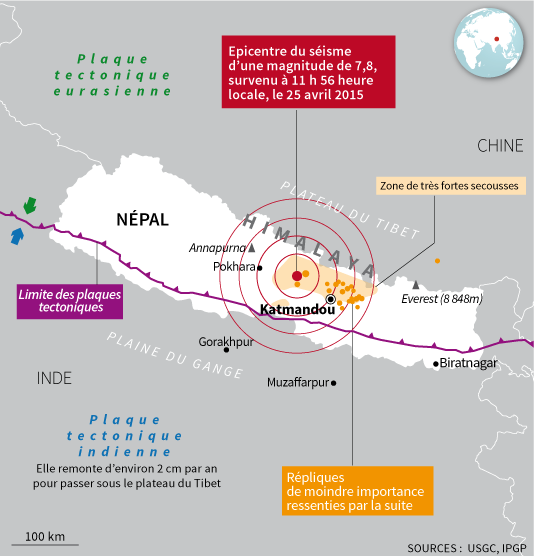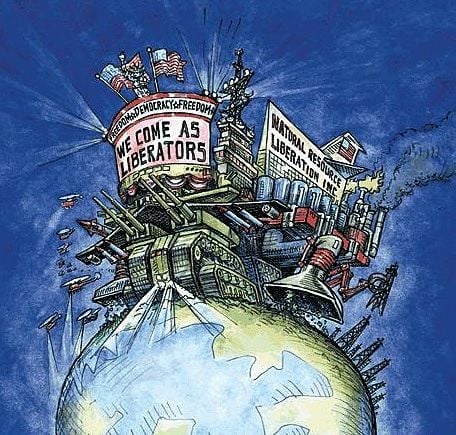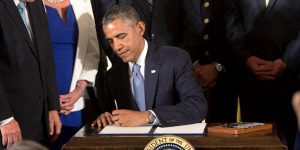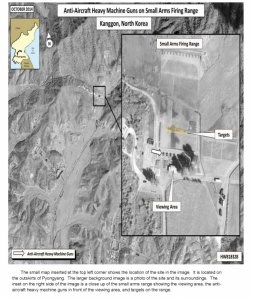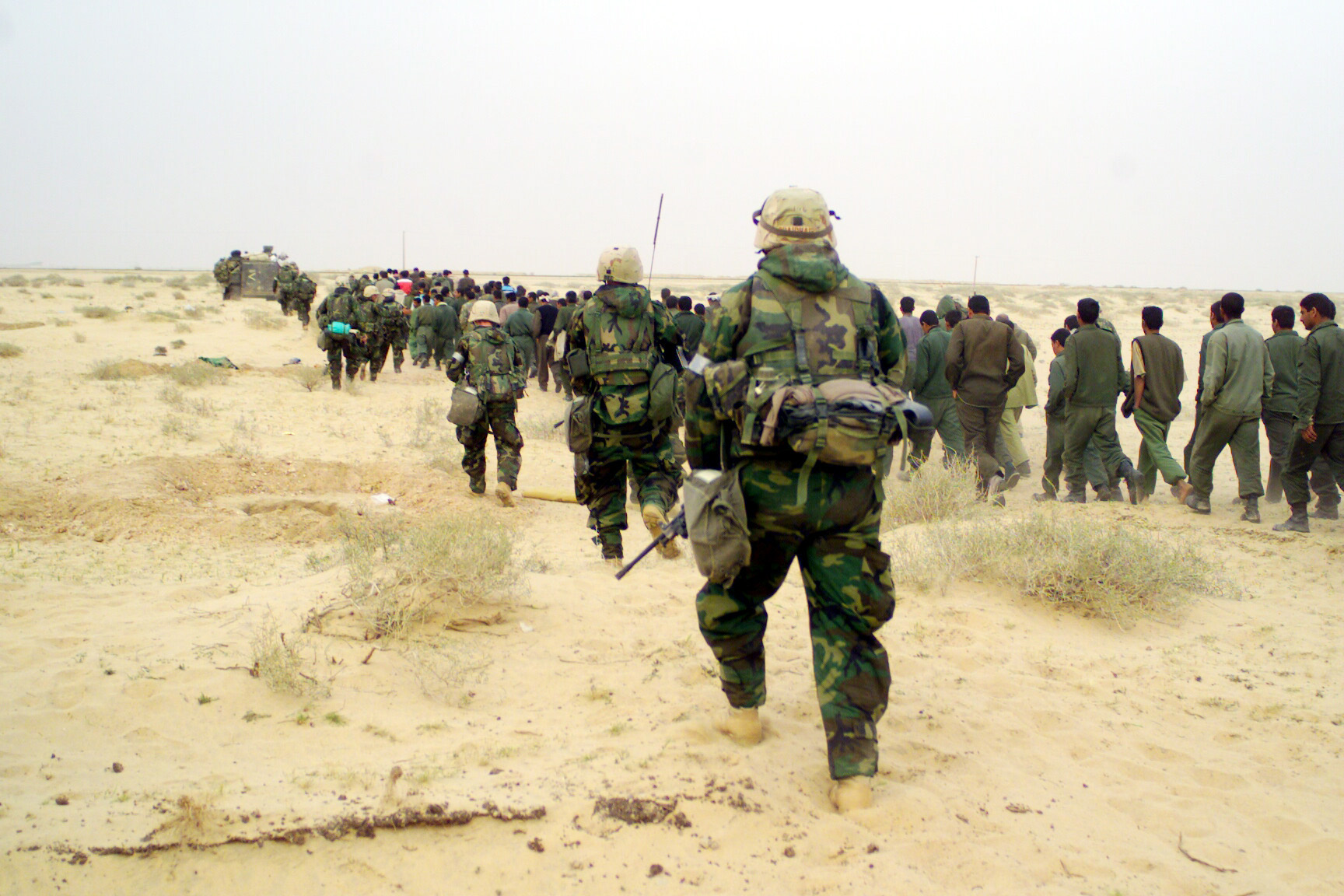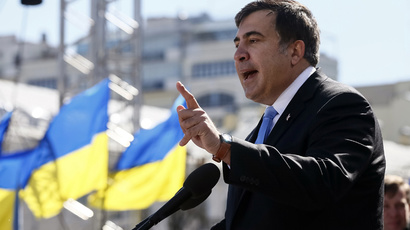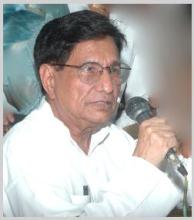Photo : Maxppp, midilibre.fr
Le XXIième siècle. le siècle de l’eau.
L’un des enjeux majeurs entourant le devenir de l’humanité est la disponibilité de l’eau. C’est le fondement de la vie et c’est le vecteur par excellence des sédiments utiles au renouvellement des sols à l’intérieur des bassins de drainage. C’est aussi, dans les zones humides, un filtre efficace. Un peu partout dans le monde, l’eau se raréfie en raison des changements climatiques qui engendrent des périodes de sécheresse prolongées comme on peut l’observer cette année en Californie, puis par suite de la surutilisation de l’eau dans les zones semi-arides irriguées, de la surexploitation des nappes aquifères et de la gouvernance déficiente du patrimoine hydrique dans les zones d’abondance.
« Aujourd’hui encore, les contentieux à propos de l’eau sont nombreux à travers le monde, notamment au Nord et au Sud de l’Afrique, au Proche-Orient, en Amérique centrale, au Canada et dans l’Ouest des États-Unis. Au Proche-Orient, par exemple, une dizaine de foyers de tensions existent. Ainsi l’Égypte, entièrement tributaire du Nil pour ses ressources en eau, doit néanmoins partager celles-ci avec dix autres États du bassin du Nil : notamment avec l’Éthiopie où le Nil bleu prend sa source, et avec le Soudan où le fleuve serpente avant de déboucher sur le territoire égyptien. Quant à l’Irak et la Syrie, ils sont tous deux à la merci de la Turquie, où les deux fleuves qui les alimentent, le Tigre et l’Euphrate, prennent leur source. L’eau de l’Euphrate a d’ailleurs souvent servi d’arme brandie par la Turquie contre ses deux voisins : grâce aux nombreux barrages qu’elle a érigés sur le cours supérieur du fleuve et qui lui permettent d’en réguler à sa guise le débit en aval, la Turquie possède là, en effet, un puissant moyen de pression ».
« Avec l’essor démographique et l’accroissement des besoins, ces tensions pourraient se multiplier à l’avenir. C’est ce que prédisent certains experts pour le XXIe siècle. D’autres en revanche pensent que la gestion commune de l’eau peut être un facteur de pacification. Ils mettent en avant des exemples étonnants de coopération : le plus fameux est celui de l’Inde et du Pakistan qui, au plus fort de la guerre qui les opposait dans les années 1960, n’ont jamais interrompu le financement des travaux d’aménagement qu’ils menaient en commun sur le fleuve Indus » (cnrs.fr).
Nous présentons, dans cet essai, les enjeux géopolitiques du processus de raréfaction de l’eau. Comment les États qui se partagent les eaux d’un même bassin de réception vont-t-ils collaborer afin d’assurer un approvisionnement sécuritaire en eau? Quelle est l’ampleur des risques liés à la diminution de l’eau dans les zones déjà fragilisées par la baisse des nappes phréatiques? Est-ce que la demande accrue de l’eau dans les mégalopoles causera des conflits majeurs? Quelle serait l’approche à privilégier dans la gestion du patrimoine hydrique mondial?
Nous examinons, dans cette deuxième partie, la problématique de l’approvisionnement de l’eau dans trois régions dans lesquelles les États s’affrontent ou cherchent à coopérer dans le partage de l’eau disponible, soit Israël, la Jordanie, la Syrie, le Liban et les territoires palestiniens de Cisjordanie dans le bassin du Jourdain, l’Inde et le Pakistan dans le bassin de l’Indus et l’Égypte et les dix autres États qui se partagent les eaux du Nil. La problématique du partage de l’eau dans ces bassins a fait l’objet de multiples analyses. Ce que nous proposons, ici, c’est d’exposer l’état des enjeux politiques actuels et les résultats des efforts consentis dans la recherche de solutions aux conflits entre les États.
Selon Peter Gleick, du Pacific Institute for Studies in Development, Environment, and Security, un total de 48 conflits a affecté autant de pays entre 2000 et 2008 (worldwater.org).
Un examen de ces conflits révèle, entre autres, les éléments suivants :
– Plusieurs conflits ont pris naissance à la suite d’une période de sécheresse prolongée. Des communautés se sont alors disputées pour le partage de l’eau encore disponible. Cela s’est produit, en 2000 et en 2001, en Éthiopie, en Afghanistan, en Chine et au Pakistan. Même s’il s’est agi ici d’incidents localisés ceux-ci ont révélé combien les tensions peuvent rapidement s’exacerber, l’eau étant vue comme un bien vital;
– Les USA auraient bombardé, en 2001, le barrage de Kajaki dans la Province du Helmand, en Afghanistan, privant du même coup d’électricité la ville de Kandahar et, en 2003, en Irak, les installations de distribution d’eau pour la ville de Bagdad;
– Des affrontements fréquents entre les utilisateurs de l’eau nécessaire à l’irrigation et, notamment, en 2002 à Garend au Cachemire, entre Karnataka et Tamil Nadu en Inde en 2002 et aussi au Mexique, en 2004, dans les environs de Pihuano (worldwater.org);
I.Le bassin du Jourdain – Syrie, Israël, Liban, Cisjordanie et Jordanie (figure 1)
Le Proche-Orient est une région fortement marquée par l’aridité et c’est dans ce contexte que se situe le bassin du Jourdain : « À part le Liban, qui ne manque pas d’eau douce, les autres pays riverains du Jourdain sont catégorisés comme étant des régions arides : 80% de la Jordanie, 60% de la Palestine-Israël et environ 65% de la Syrie » (R. Faraj, 2005).
Le Jourdain, d’une longueur de 360 km, draine une superficie de 18 300 kilomètres carrés (figure 2).
« Le bassin du Jourdain est partagé entre quatre pays : Israël, la Jordanie, la Syrie et le Liban, auxquels il faut ajouter les territoires palestiniens de Cisjordanie. Le Jourdain prend sa source dans le Mont Hermon, au Liban, qu’il parcourt sur 21 km. Il passe la frontière israélienne et arrive au lac Houleh (maintenant asséché), lieu de rencontre avec trois affluents (Hasbani, Banias, Dan). Ensuite, il parcourt 17 km de gorges étroites et arrive au lac de Tibériade, où la salinité est forte, d’autant plus que des cours d’eau douce s’y jetant ont été détournés. Le lac de Tibériade reçoit cependant les eaux des multiples petits cours d’eau traversant les hauteurs du Golan. Ensuite, le Jourdain rencontre la rivière Yarmouk (arrivant de Syrie), puis décrit des méandres sur 320 km (109 km à vol d’oiseau) pour atteindre la mer Morte. Ces 320 km sont occupés par une plaine humide (le zor humide), à la végétation subtropicale, dominée des deux côtés (cisjordanien et jordanien) par des terrasses sèches et ravinées » (figure 2).
(http://www.lesclesdumoyenorient.com/Eau-et-conflits-dans-le-bassin-du.html).
Figure 1. Le Proche-Orient
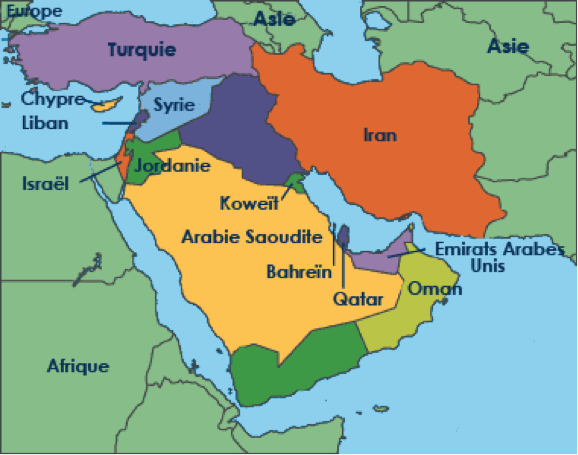
Source : http://djitiivan.centerblog.net/4667892-proche-orient
Figure 2. Le bassin versant du Jourdain
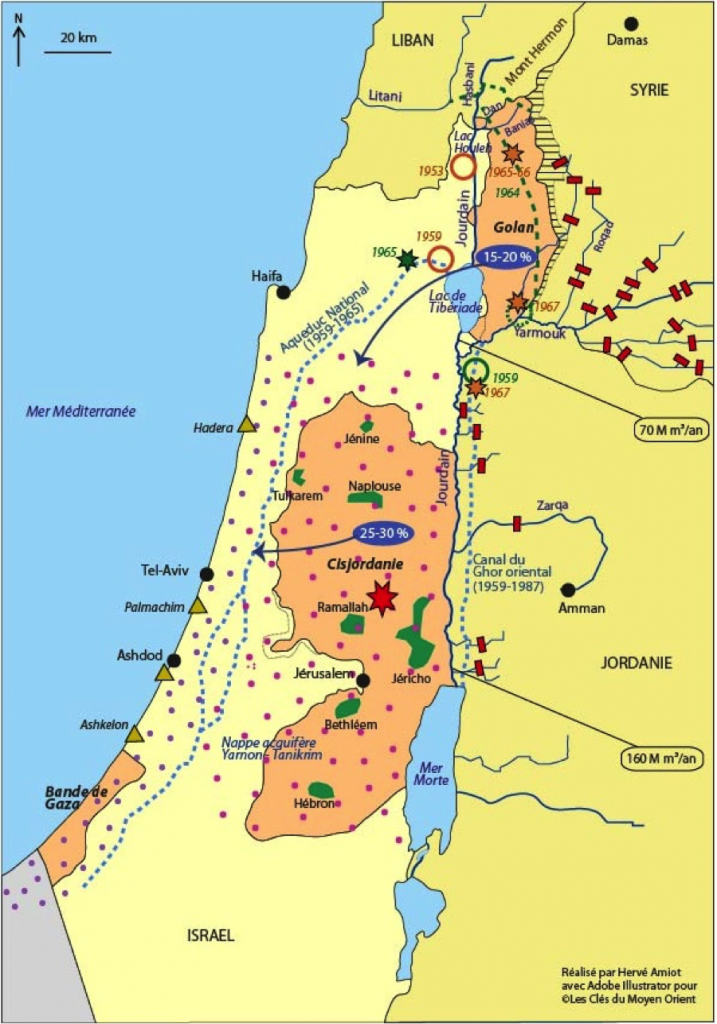
Source : http://www.lesclesdumoyenorient.com/Eau-et-conflits-dans-le-bassin-du.html
Figure 3. Rivière près du camp de réfugiés d’Al Faraa tarie l’été en raison du pompage excessif de ses eaux en amont par les colons israéliens
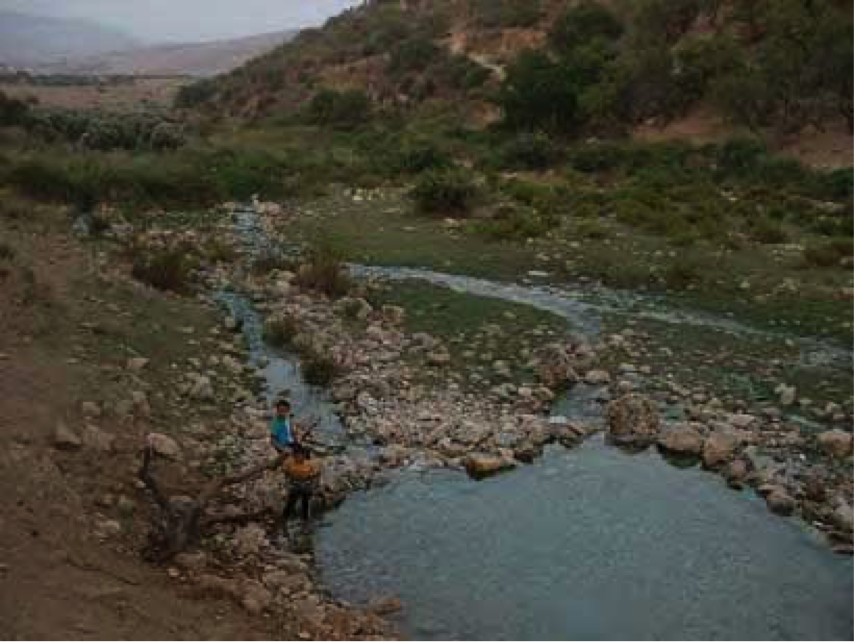
Source : http://www.ism-france.org/analyses/Le-role-de-l-eau-dans-la-politique-israelienne-d-occupation-de-la-Palestine-article-6585
L’eau dans le bassin du Jourdain : une ressource rare et convoitée (figures 2 et 3)
Selon Dubois (2012), « Le Proche-Orient, avec le bassin du Jourdain, figure comme l’une des principales zones de conflits liés à l’eau dans le monde, où trois États et la Palestine tentent de se partager une ressource rare. L’or bleu est-il alors source de conflits ou de paix? » (youphil.com).
« Israël, la Palestine, la Jordanie et la Syrie: un quatuor en pleine situation de stress hydrique. En d’autres termes, ces pays, situés dans une région dite aride, ont des besoins en eau supérieurs aux ressources existantes et disponibles. La forte pression démographique de ces dernières années et le changement climatique aggravent la situation. Le fleuve Jourdain constitue le principal réservoir d’eau de la région et dessine une frontière naturelle entre Israël et la Jordanie. Son débit représentait il y a encore quelques années près de 1,3 milliard de m3 par an, une fois jeté dans la mer Morte. On estime son débit à près de 20 à 30 millions par an. Son affluent, le Yarmouk, prend lui sa source en Syrie avant d’atteindre les terres jordaniennes. Le plateau du Golan, avec le lac de Tibériade, se situe en territoire syrien et constitue une zone stratégique: Israël l’a compris et l’a annexé en 1981. Enfin, les ressources aquifères souterraines assurent une large part de l’approvisionnement en eau du bassin ».
« La mauvaise gestion de l’eau, “on l’oublie souvent”, n’a fait qu’aggraver la situation déjà critique du bassin (déperdition de près de 50% de l’eau acheminée en Jordanie due au mauvais état des canalisations, etc.). Par conséquent, le niveau du Jourdain baisse dangereusement au fil des années. En 2010, le porte-parole de l’Autorité pour l’eau a indiqué que la simple consommation domestique d’eau potable en Israël s’élevait à 700 millions de m3. Face à ces faibles ressources en eau, les disparités régionales et dépendances se creusent et les pressions exercées par Israël compliquent la donne ».
Selon Rezeq Faraj (2005), brossant un tableau de la situation dans l’ensemble du bassin versant, « les ponctions excessives dans le Jourdain et le Yarmouk ainsi que le pompage par Israël du lac Tibériade ont transformé le Jourdain en une rivière qu’on traverse à pied. Il n’y a presque plus d’eau qui se déverse dans la mer Morte…Les ressources en eau du Jourdain sont surexploitées. Cette situation alarmante est due à l’augmentation de la population et aux besoins agricoles et industriels. De plus, la pollution a grandement détérioré la qualité de l’eau disponible dans le bassin fluvial. Le partage de l’eau entre les pays riverains n’est basé sur aucun accord, aucune négociation ni aucun principe d’équité » (R. Faraj, 2005).
Israël, gendarme de l’eau
« L’État hébreu domine le bassin sans disposer de réelles ressources en eau sur son territoire. Il détourne et puise ainsi illégalement et sans limites dans le fleuve Jourdain et les ressources aquifères souterraines, situées en territoires palestiniens (principalement en Cisjordanie). De plus, l’occupation du Sud-Liban jusqu’en 2000 lui a permis de prendre le contrôle de deux affluents du Jourdain. “L’opération portait même le nom du fleuve…”, rapporte Pierre Berthelot. C’est dire l’importance de l’eau dans le contexte géopolitique. “Israël veut être le gendarme de la question de l’eau dans la région”, au détriment des Palestiniens qui font face à un accès à l’eau restreint malgré l’accord d’Oslo II en 1995 qui reconnaît le droit à l’eau pour ces populations mais sans établir de ratio précis ».
« Au détriment également des Jordaniens. Un traité de paix a pourtant été adopté en 1994 entre Israël et la Jordanie, instaurant une coopération multilatérale notamment pour la répartition de l’eau provenant de sources communes. Pour Pierre Berthelot, “la Jordanie est à la fois alliée et otage d’Israël”, bloquée entre son accord avec Israël, son projet avorté (par Israël!) de barrage avec la Syrie sur le Yarmouk et ses relations tendues avec ses autres voisins (Irak, Arabie Saoudite). Pour pouvoir continuer son développement économique, la Jordanie a besoin d’eau et “dépend alors de la bonne volonté de son voisin” ».
« Le contrôle de la terre, pour des raisons politique ou encore sécuritaire, se révèle donc être aussi un contrôle de l’eau pour l’état hébreu. Son déficit hydrique se creuse toujours plus. “Israël considère qu’il est menacé à tous les niveaux dans la région (montée de l’islamisme, révolte en Syrie, attitude face à l’Iran…), des menaces réelles ou fantasmées d’ailleurs. Il utilise donc la carte de l’eau. Si l’on suit sa logique, un pays qui fait face à un tel flux de menaces a le droit de jouer cette carte.” Comment envisager de partager une ressource si rare avec ses voisins et risquer de se mettre soi-même en péril? » (youphil.com).
Tensions, projets et paix?
« Une telle mainmise sur l’eau par Israël oblige ses pays voisins à détourner ces eaux. La Syrie tente ainsi de puiser dans le Yarmouk, en aval du lac de Tibériade, en construisant des puits. La surexploitation des nappes phréatiques entraîne, elle, une importante salinisation des eaux. Israël a alors développé un réseau d’usines de dessalement d’eau de mer afin de réduire sa dépendance au Jourdain ou encore aux ressources aquifères, dont les jours sont comptés. Problème, “on agit sur l’offre. Il faudrait plutôt agir sur la demande et responsabiliser les populations”, commente Pierre Berthelot. De plus, ces usines sont “vulnérables” et pourrait être visées par des missiles ennemis. “On se met dans une position de dépendance dangereuse.”
« La question de l’eau est-elle alors déterminante pour parvenir à un accord de paix entre Israël et la Palestine? “Ce n’est, à mon sens, pas le point de blocage principal et il y a toujours des alternatives, des compromis à trouver.” La situation au Proche-Orient est préoccupante mais la guerre de l’eau n’est pas à craindre: “c’est le statu quo et nous ne sommes pas prêts d’en voir le bout”, conclut le chercheur » (youphil.com).
L’Accord de 2013. La nécessité de s’entendre. De l’eau de la Mer Rouge pour la Mer Morte
Des représentants d’Israël, de Jordanie et de l’Autorité palestinienne ont signé, le 9 décembre 2013, à Washington, un accord qualifié d’« historique » pour tenter de sauver la mer Morte et lutter contre la pénurie d’eau dans la région. Aux termes de l’accord obtenu après onze ans de négociations, un système de pompage va être mis en place dans le golfe d’Aqaba, à la pointe nord de la mer Rouge, afin de collecter quelque 200 millions de mètres3 d’eau par an. Une partie sera ensuite acheminée par l’intermédiaire de quatre conduits vers la mer Morte, une mer fermée ayant une très haute concentration en sel et qui risque de s’assécher d’ici à 2050 ».
« Cela offre une lueur d’espoir sur la possibilité de surmonter d’autres obstacles à l’avenir », a estimé le ministre israélien de l’eau et du développement, Sylvan Shalom, en paraphant l’accord au siège de la Banque mondiale, partenaire du projet. Nous avons montré que l’on pouvait travailler ensemble en dépit de nos problèmes politiques », a ajouté son homologue palestinien, Shaddad Attili, présent à la même tribune, à l’heure où Palestiniens et Israéliens tentent de relancer le processus de paix sous l’égide des Etats-Unis ».
Au-delà des problèmes politiques
Une autre partie de l’eau pompée dans la mer Rouge sera dessalée, et distribuée en Israël et en Jordanie afin de répondre à la pénurie d’eau qui frappe la région. L’Etat hébreu a également accepté de laisser s’écouler davantage d’eau du lac de Tibériade, situé sur son territoire, en direction de son voisin jordanien, a précisé la Banque mondiale dans un communiqué.
« Sans eau, il n’y aura pas de développement économique, pas d’emploi », a commenté le ministre jordanien de l’eau et de l’agriculture, Hazim El-Nasser, qui a lui aussi signé l’accord à Washington ».
« Israël a par ailleurs accepté de vendre à l’Autorité palestinienne entre « 20 à 30 millions de mètres cubes » par an d’eau dessalée fournie par l’entreprise publique israélienne de production d’eau potable, Mekorot. « En dépit de nos problèmes politiques, nous partageons les mêmes problèmes liés au manque d’eau », a relevé M. Attili.
Fragile écosystème de la Mer Morte
« Dans son communiqué, la Banque mondiale assure que la Cisjordanie…bénéficiera de ces nouveaux arrangements; mais lors de la conférence de presse, le ministre palestinien a assuré que la bande de Gaza…en profiterait également. Selon les trois parties, un appel d’offres international devrait être lancé pour l’ensemble du projet, en commençant par l’usine de dessalement d’Aqaba et l’installation du premier conduit. L’appel d’offres devrait être lancé dès 2014, selon le ministre israélien ».
« Partenaire de l’opération, la Banque mondiale a publié en 2012 une étude penchant vers la faisabilité du projet, mais plusieurs organisations de défense de l’environnement ont déjà mis en garde contre les possibles effets néfastes de l’arrivée d’eau de la mer Rouge sur le fragile écosystème de la mer Morte. Selon le communiqué de l’institution, le lancement du projet devrait permettre, « sous le contrôle des scientifiques », de mieux comprendre les conséquences d’un mélange des eaux de la mer Rouge avec celles de la mer Morte » (lemonde.fr).
La nécessité impérative de s’entendre
Selon l’Institut européen de recherche sur la coopération méditerannéenne et euro-arabe, les divers conflits du Moyen-Orient sont sous-tendus et parfois exacerbés par un enjeu vital dans cette région aride: l’eau.
« Tous les pays arabes de la région sont confrontés à une pénurie qui est en passe de devenir extrêmement grave sous l’effet de trois facteurs: le taux de croissance démographique combiné à une forte urbanisation, la mise en oeuvre d’ambitieux projets de développement agricole nécessitant une importante irrigation et enfin la dégradation des ressources existantes (salinisation des nappes phréatiques, par exemple).
Le contrôle des ressources en eau est donc une nécessité vitale pour ces États et les a conduits à élaborer des stratégies visant à s’approprier les grands réservoirs d’eau aux dépens de leur(s) voisin(s). Cette raréfaction de l’eau et ses enjeux imposent une relecture des conflits de la région, notamment entre Israël et les États arabes.
Partant du nord de la zone moyen-orientale pour descendre jusqu’à l’Afrique orientale, citons: la dispute Irak/Syrie/Turquie à propos de l’Euphrate et, dans une moindre mesure, du Tigre; le détournement par Israël depuis 1982, sur le territoire libanais, des eaux du Litani; le litige entre Israël, la Syrie et la Jordanie à propos du Jourdain et de son principal affluent, le Yarmouk; l’enjeu du partage des nappes aquifères palestiniennes entre Israël et les Territoires palestiniens; la tension constante entre pays riverains du Nil, particulièrement l’Egypte, le Soudan et l’Ethiopie.
« Les divers projets – cet « aqueduc de la paix » proposé par la Turquie et l’idée d’un « canal de la paix » entre l’Egypte et Israël pour y amener l’eau du Nil – tendant à résoudre ce problème de la raréfaction des ressources hydrauliques dans ces différents pays prouvent combien cet élément naturel qu’est l’eau en a détrôné un autre, le pétrole, et combien cette pénurie croissante risque de provoquer une radicalisation des conflits existants et même d’en déclencher d’autres » (medea.be).
Le monopole de l’eau du Jourdain par Israel demeure toujours une réalité criante
Le problème de l’eau est l’un des facteurs les plus importants qui affectent le conflit entre Israël et la Palestine. L’Etat juif a besoin de contrôler les sources d’approvisionnement des eaux du Jourdain et les aquifères des villes de Gaza et de la Cisjordanie étant donné la faible pluviométrie dans la région. La politique de l’eau de ce pays est l’un des enjeux géostratégiques clés pour leur subsistance. En 1967, après l’occupation totale de la Cisjordanie et de la bande de Gaza, Israël a déclaré comme étant sa propriété toutes les ressources en eau. Les Palestiniens doivent obtenir un permis de l’armée israélienne avant de développer toute infrastructure liée à l’eau sur leurs terres (teinteresa.es).
II.Le bassin du Nil – L’Égypte et les États situés dans le cours supérieur du fleuve
Le bassin du Nil est le 3e plus grand bassin versant du monde, après ceux de l’Amazone et du Congo. Il couvre une superficie de 3 254 555 km², soit 10 % du continent africain. Il s’étend sur les pays suivants : Il draine la quasi-totalité du Burundi; il est le seul cours d’eau permanent d’Égypte; il traverse le sud-ouest de l’Érythrée et le sud-ouest et le tiers occidental de l’Éthiopie, quelques petites parties de l’ouest du Kenya et la totalité du territoire de l’Ouganda; en République démocratique du Congo il baigne une toute petite partie du pays, à l’est, autour des lacs Édouard et Albert, il couvre la quasi-totalité du Rwanda, du Soudan et du Sud-Soudan (figure 4).
Le Nil est formé par la confluence du Nil Bleu et du Nil Blanc à Khartoum. Après cette confluence, le seul affluent d’importance est l’Atbara. Le Nil parcourt ainsi la moitié de son cours sans affluent permanent, à travers le Sahara (wikipedia.org).
Figure 4. Carte politique du bassin versant du Nil
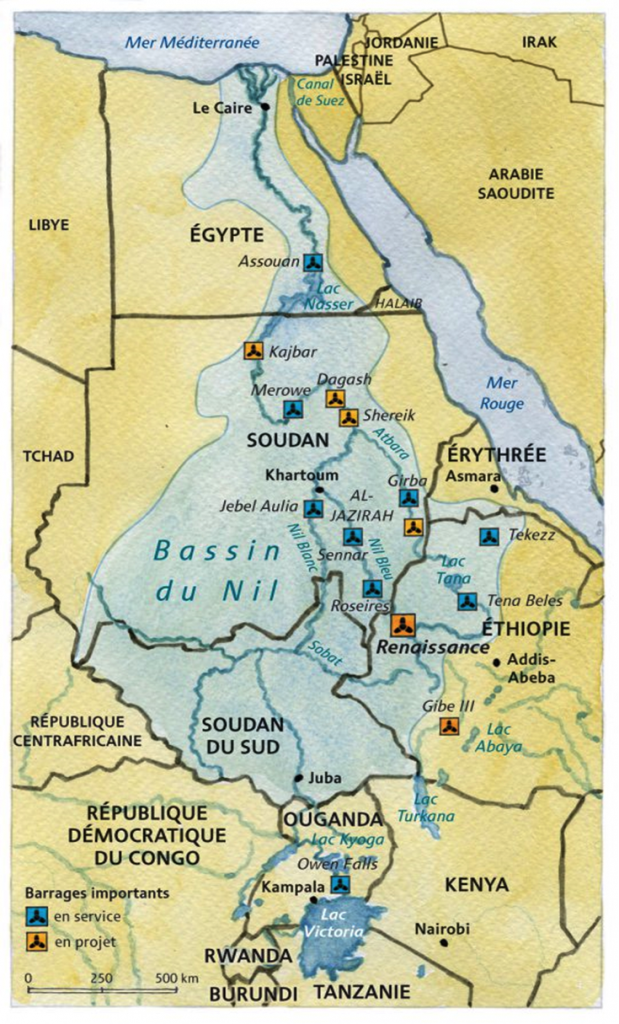
En ligne : http://www.monde-diplomatique.fr/cartes/nil
Figure 5. Vue du Nil bleu

En ligne : http://www.larousse.fr/encyclopedie/riviere-lac/le_Nil/135315
Larbi Bouguerra et Olivier Petitjean, dans un texte très bien élaboré publié en 2009, faisaient le point sur le contentieux entre les pays qui se partagent les eaux du Nil et, tout spécialement, entre l’Égypte, le Soudan et l’Éthiopie. Les projets de mise en valeur du fleuve pour des fins énergétiques et pour l’irrigation des terres ont eu tendance à se multiplier ces dernières années dans l’ensemble du bassin versant : « L’Éthiopie a annoncé des projets grandioses – principalement des barrages – pour augmenter ses zones irriguées et produire de l’énergie électrique. L’Ouganda cherche également à combler son manque d’électricité en construisant des centrales sur le fleuve. Le Soudan a lui aussi annoncé plusieurs projets de nouveaux barrages… Plus en amont, les pays riverains du lac Victoria (Ouganda, Tanzanie, Kenya), confrontés à la sécheresse, souhaitent obtenir l’accès à l’eau de cette vaste étendue d’eau douce, source du Nil Blanc, pour leurs projets agricoles et hydroélectriques. Pour ce faire, ils militent pour l’abrogation d’un traité datant de l’époque coloniale qui réserve le lac aux pêcheurs et aux baigneurs. Ce traité avait été imposé encore une fois par les Britanniques au bénéfice des Égyptiens. Ces derniers n’ont pas manqué de répliquer en soulignant le laisser-aller qui a toujours prévalu dans ces pays quant à la gestion des ressources en eau, de la pollution et des pêcheries. Kenya, Tanzanie et Ouganda ont créé la Commission tripartite du bassin du lac Victoria pour se prémunir contre les critiques de ce type ainsi que pour défendre leurs intérêts face aux pays d’aval » (partagedeseaux.info).
L’annonce de la mise en chantier du projet d’un grand barrage par l’Éthiopie allait provoquer, en Égypte, une vague d’inquiétudes en remettant en question le partage des eaux décidé par le Traité signé en 1959 entre l’Égypte et le Soudan dans le cadre des travaux du barrage d’Assouan : «D’ores et déjà, les besoins en eau de l’Égypte sont estimés à 73 milliards de mètres cubes par an, soit près de 20 milliards de plus que leur part théorique de l’eau du Nil. La nervosité du gouvernement égyptien est donc à la mesure de sa vulnérabilité. Toute annonce de projet lié au Nil dans un autre pays est dès lors considérée d’emblée comme un problème de sécurité nationale pour l’Égypte » (partagedeseaux.info).
Au cours des dernières années, les États du Nil ont continué de coopérer dans le cadre de nombreuses initiatives et de nombreux projets communs visant à « contrebalancer les désaccords et les motifs de conflit, reflétant une volonté constructive indéniable de la part des pays concernés…Les pays concernés sont d’ailleurs regroupés désormais au sein d’une instance coopérative de gestion du fleuve et de résolution des conflits, l’Initiative pour le bassin du Nil (Nile Basin Initiative, NBI), basée à Nairobi (Kenya) et à Kampala (Ouganda). L’Égypte, de son côté, ne fait pas preuve d’une mauvaise volonté absolue à l’égard des pays d’amont ; elle essaie au contraire de prendre les devants (tout en gardant le contrôle de la situation…) en lançant diverses initiatives de coopération. Elle a lancé une politique de coopération technique avec les pays d’amont, dite politique de l’Endugu (entente en swahili). Elle coopère aussi avec le Soudan sur le projet de barrage de Mérowé, à 350 kilomètres au Nord de Khartoum. Le projet du barrage de Bujagali en Ouganda, à la sortie du lac Victoria, est également soutenu par la NBI et donc par l’Égypte (il est en revanche très fortement critiqué par les environnementalistes). Selon certains observateurs, c’est là que réside la clé du problème : l’Égypte pourrait parvenir à un accord ne remettant pas en cause sa part du Nil en contre-patrie d’un accroissement de ses aides techniques et financières aux pays d’amont » (partagedeseaux.info). .
La poursuite des efforts de coopération ont donné leurs fruits. Le 23 mars dernier, après plusieurs années de tensions entre l’Égypte, le Soudan et l’Éthiopie, les trois pays africains ont finalement réussi à conclure un accord pour que le futur barrage éthiopien, le plus grand d’Afrique, n’affecte en rien le débit des eaux du fleuve. L’accord de principe qui autorise la construction du barrage « grande renaissance » (wikipedia.org) a été signé à Khartoum entre le président égyptien Abdel Fatah al-Sissi, son homologue soudanais Omar el-Béchir et le premier ministre éthiopien Hailemariam Desalegn. En signant cet accord, les trois pays tournent la page d’une longue série de tensions qui a débuté en mai 2013, date à laquelle le gouvernement éthiopien a commencé à détourner les eaux du Nil bleu pour construire ce barrage de plus de 6 000 mégawatts (sahel-intelligence.com).
III.Le bassin de l’Indus – Inde et Pakistan (figure 6)
« Trois grands bassins. L’Indus, le Gange et le Brahmapoutre. Les zones les plus densément peuplées du monde, un demi-milliard de personnes vivent autour du seul Gange. 70 % du milliard et demi de personnes qui vivent en Asie du Sud sont des familles qui tirent leurs revenus de l’agriculture et a fortiori, dépendent de ces bassins pour vivre. Ce chiffre augmente de 25 millions tous les ans. Depuis des générations, ces bassins ont irrigué les plaines du Pendjab, les champs de coton et les vergers du Sindh et les rizières du Bangladesh, faisant croître la productivité de la région plus rapidement qu’autre part. Mais les ressources en eau de l’Asie du Sud sont irrégulières, difficilement prédictibles. Entre moussons dévastatrices et inondations, puis sécheresses à répétition, la région a de plus en plus de mal à faire face à l’augmentation de la demande en eau. Quand l’eau des moussons s’avère être modérée, aucune infrastructure ne permet de la récupérer et de la conserver » (lorbleu.blog.youphil.com).
Le plus grand réseau d’irrigation du monde, qui avait été mis en place par l’administration britannique, a été brisé, en 1947, par le partage du Panjab, le pays des cinq fleuves, entre les deux éternels rivaux que sont l’Inde et le Pakistan.
Le climat de tensions intenses concernant le partage de l’eau du fleuve Indus est bien connu. Des confrontations entre les deux pays se sont produites à quatre reprises au cours du XXème siècle (1947, 1965, 1971, 1999) concernant cet enjeu primordial.
Selon Clemens, la signature du Traité des eaux de l’Indus (« l’Indus Waters Treaty ») en 1960 et la création de la Commission bilatérale pour les eaux de l’Indus, une distribution équitable des eaux a pu être rétablie entre les deux États. Selon cet auteur malgré de nombreuses frictions, aucune « guerre de l’eau » n’a éclaté jusqu’ici entre ces deux États » (rural21.com).
Du Tibet à la Mer d’Oman (figures 6 et 7)
« La source de l’Indus se trouve au Tibet au mont Kailâs ou Gangri, en effet, il porte son nom à partir de la confluence des torrents Sengge et Gar descendant de l’Himalaya et drainant les chaînes du Nganglong Kangri et du Gangdise Shan. L’Indus passe ensuite au nord-ouest au travers du Cachemire au sud de la chaîne du Karakoram, puis graduellement se tourne vers le sud, quittant les collines entre Peshawar et Rawalpindi. Dans ce secteur un barrage forme le réservoir de Tarbela. À partir de sa confluence avec la rivière Kaboul, l’Indus devient navigable ».
« Le reste de son trajet vers la mer se déroule ensuite dans les plaines du Pendjab et du Sind, et le fleuve prend alors un cours très lent. Il traverse Hyderâbâd puis se jette dans la mer d’Oman par un grand delta aride de 7 770 km2 s’étendant sur 200 km de côte, au sud-est de Karâchi, maintenant considérée comme l’une des régions écologiques les plus importantes au monde » (http://fr.wikipedia.org/wiki/Indus).
Figure 6. Bassin versant de l’Indus
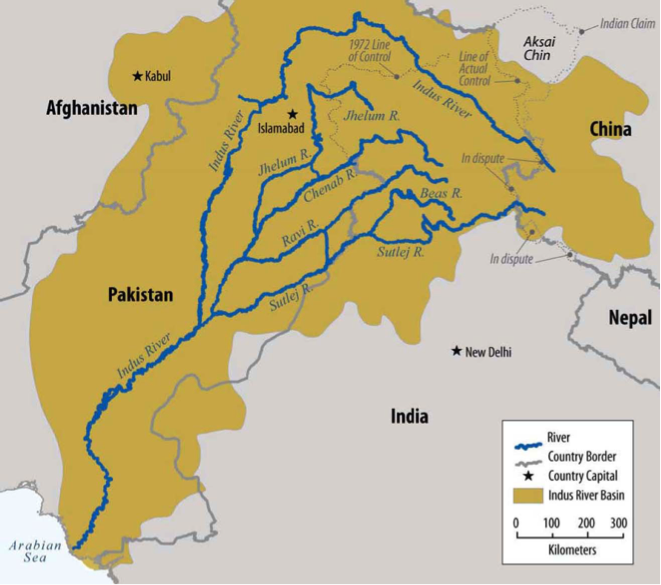
Source : https://foeme.wordpress.com/2012/12/30/cooperating-over-water/map-of-the-indus-basin-source-us-senate-report/
Figure 7. L’Indus. Vue à partir de l’autoroute Karakouram
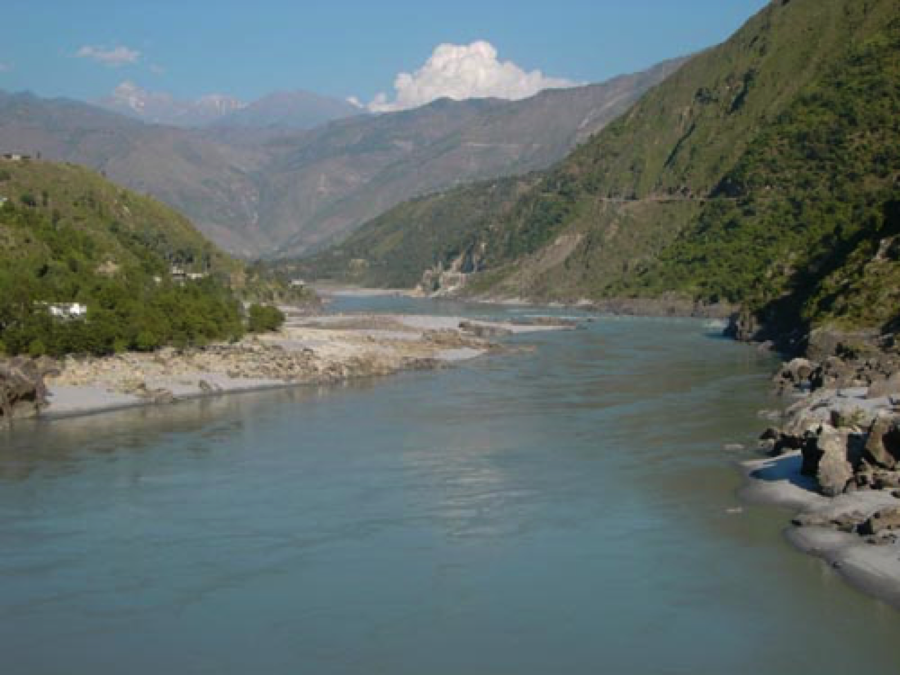
Source : http://www.waa.ox.ac.uk/XDB/tours/indus3.asp
Depuis mai 2012, l’enjeu stratégique autour de l’eau de la région Nord-est de l’Inde a redoublé de vigueur. Le ton est devenu si virulent que les experts les plus sérieux finissent par se demander si la prochaine guerre entre Islamabad et New Delhi…n’éclatera pas en raison des contentieux qui les opposent autour de l’Indus.
Selon le Pakistan, New Delhi tirerait partie de son atout géographique – l’Indus et cinq de ses affluents traversent l’Inde avant d’arriver au Pakistan – pour manipuler la ressource hydraulique à son avantage par le biais de barrages et de réservoirs. La question n’est pas nouvelle ; elle s’est posée dès l’indépendance des deux États. Mais jamais le Pakistan n’a autant haussé le ton alors que le traité de l’Indus de 1960, qui codifie le partage des eaux entre les deux pays, montre ses limites.
Le Pakistan agite la menace d’une guerre de l’eau
En mai 2012, lors d’une réunion du comité spécial du Parlement pakistanais sur la question du Cachemire, la question de l’eau et de sa gestion avec le voisin indien est revenue au devant de la scène. Présidée par Maulana Fazhur Rahman, le leader de Jamiat Ulema-i-Islam, un des partis islamistes de l’alliance Muttahida Majlis-e-Amal, les discours se sont montrés virulents à l’encontre de l’Inde. Le comité a accusé l’Inde de « terrorisme de l’eau » et a demandé à ce que l’on stoppe l’Inde dans ses démarches de construction de barrages, en cours et à venir.
« Toutes les solutions, y compris juridiques, doivent être envisagées pour que l’Inde cesse toute construction de barrages. Selon le Traité de partage de l’Indus, l’Inde ne peut pas voler l’eau de nos rivières » a-t-il déclaré. L’eau est déjà une cause reprise par les terroristes. Le chef présumé de l’attentat de 2008 à Mumbai, Hafiz Saeed, a souvent reproché à l’Inde d’agir tels des « terroristes de l’eau », menaçant le peuple indien « d’inondations, qu’elles soient d’eau ou de sang ». Lashkar-e-Taiba, le groupe terroriste impliqué dans ces mêmes attentats, a par ailleurs souvent menacé l’Inde de faire exploser les barrages et a condamné avec virulence la politique de l’eau menée par le gouvernement indien » (lorbleu.blog.youphil.com)
En 2011, le journal pakistanais Nawa-i-Waqt a pressé le gouvernement d’agir : « Le Pakistan devrait faire comprendre à l’Inde qu’une guerre est possible sur le sujet de l’eau et que cette guerre sera nucléaire ». La plupart des experts s’accordent à faire d’un tel conflit quelque chose de peu probable, mais la pression augmentant, des disputes à petite échelle se répandront dans la région » (lorbleu.blog.youphil.com).
Début mai 2011, c’était le groupe International Crisis Group (ICG) qui évaluait dans un rapport les conséquences de cette situation sur la paix mondiale et alarmait d’une possible aggravation de ces conflits. L’ICG attirait l’attention sur l’éventualité d’une guerre entre le Pakistan et l’Inde si cette dernière ne permettait pas à l’eau de s’écouler vers le Pakistan. Il attirait également l’attention sur un rapport publié l’an dernier par le Comité des Affaires étrangères du Sénat Américain, statuant que l’Inde était en train de construire trois nouveaux barrages sur le Chenab et le Sutlej, deux affluents de l’Indus qui, selon les termes du traité de l’Indus de 1960, reviennent au Pakistan (lorbleu.blog.youphil.com).
Le Traité de l’Indus insuffisant
Le conflit entre l’Inde et le Pakistan à propos de l’eau questionne un accord de partage des fleuves vieux de plusieurs décennies qui a été témoin de trois guerres, de conflits territoriaux constants, d’essais nucléaires et d’attaques terroristes. Le Traité de l’Indus, signé en 1960, donne le droit au Pakistan sur les fleuves situés à l’ouest de la vallée de l’Indus. L’Inde contrôle la partie est du bassin (lorbleu.blog.youphil.com).
Conclusion
Les trois cas analysés dans cet exposé démontrent, dans les faits, la nécessité d’une coopération internationale dans le règlement des tensions et des conflits concernant le partage de l’eau. La raréfaction de la ressource dans le bassin du Jourdain rend cette coopération encore plus impérative. Le statu quo ne pourra pas durer très longtemps. L’accord signé en 2013 entre les Parties ne règle pas la problématique de la gestion de l’ensemble de ce complexe hydrique. Il faut absolument aller plus loin pour assurer un partage équitable et juste de la ressource.
Dans le bassin du Nil l’entente signée récemment permet d’envisager la poursuite de la collaboration entre l’Égypte, le Soudan et l’Éthiopie entre eux et aussi avec les autres États intéressés. Pour le bassin de l’Indus les tensions entre l’Inde et le Pakistan semblent s’intensifier par suite des actions posées par l’Inde dans le bassin de réception du fleuve. Il est à espérer que des négociations et beaucoup de diplomatie permettront d’éviter une guerre entre les deux pays.
Le droit à l’eau. Un droit fondamental
En sa Soixante-quatrième session et sa 108e séance plénière, le 8 juillet 2010, l’Assemblée générale des Nations Unies a « reconnu », dans une résolution adoptée par 122 voix et 41 abstentions, le droit à une eau potable salubre et propre comme un droit fondamental, essentiel au plein exercice du droit à la vie et de tous les droits de l’homme…Cette résolution sur le droit fondamental à l’eau, « pétrole du siècle de la soif que sera le XXIe siècle » selon les mots du représentant du Yémen, les explications de vote ont opposé les tenants de l’inexistence de ce droit à ceux qui le voient reconnu dans les instruments internationaux relatifs aux droits de l’homme dont le Pacte international relatif aux droits économiques, sociaux et culturels » (un.org).
Pour le partage de l’eau la coopération est impérative
La carte mondiale de l’eau douce montrant une distribution très inégale de cette ressource invite toutes les nations à collaborer à l’émergence d’un plan mondial de coopération pour le partage juste et équitable de cette richesse. Ainsi, le jour n’est pas loin ou l’on verra l’espace terrestre sillonné par des aqueducs à l’instar des couloirs pour le pétrole et le gaz. Ces ouvrages seront construits dans la perspective de rendre une eau de qualité disponible pour tous. Ils deviendront, nous l’espérons, un maillage de paix pour toutes les régions du Globe. Si des ententes ont été paraphées pour le partage de l’eau dans les bassins du Nil et de l’Indus il devrait prévaloir aussi dans le bassin du Jourdain. D’ailleurs, on ne pourrait pas concevoir la création d’un État palestinien viable sans cette ressource indispensable et vitale. Nous croyons, ici, que l’approvisionnement suffisant en eau douce de la Palestine ne doit pas faire l’objet de négociations, mais devrait être reconnu comme un droit inhérent de l’être humain et respecté comme tel.
L’avenir
“La planète est confrontée à un déficit de 40% de l’approvisionnement en eau d’ici 2030, à moins d’améliorer considérablement la gestion de esta ressource précieuse. Telle est la conclusion inévitable dans « The 2015 United Nations World Water Development », rapport, «L’eau pour un monde durable”, lancé à New Delhi en Inde le 20 mars 2015.
“Il y a déjà un consensus international à l’effet que l’eau et son assainissement sont essentiels à la réalisation de nombreux objectifs de développement durable. Ils sont inextricablement liés au changement climatique, à l’agriculture, à la sécurité alimentaire, à la santé, à l’énergie, à l’égalité, l’égalité homme-femme et à l’éducation. Maintenant, nous devons regarder vers l’avant à la mesurabilité, le suivi et la mise en œuvre », explique Michel Jarraud, président de l’ONU-Eau et Secrétaire général de l’Organisation météorologique mondiale” (http://www.unesco-ihe.org/sites/default/ fichiers / wwdr_2015.pdf).
« D’ici 2050, la demande en eau devrait augmenter de 55 %, non seulement sous la pression d’une population croissante (la Terre comptera alors 9,5 milliards de personnes), mais aussi parce que la consommation s’envole. Les besoins de l’industrie devraient exploser de 400 % d’ici-là. Quant au secteur agricole, ses prélèvements actuels ne sont pas soutenables, estiment les experts. Entre 1961 et 2009, les terres cultivées se sont étendues de 12 %, tandis que les superficies irriguées augmentaient de 117 % » (http://www.lemonde.fr/ressources-naturelles/article/2015/03/20/la-crise-de-l-eau-illustree-en-5-graphiques_4597592_1652731.html).
Selon les Nations Unies, l’eau pourrait causer huit conflits importants au cours des prochaines années:
1) Le bassin du Jourdain au cœur du conflit israélo-palestinien;
2) Le contrôle par la Turquie des bassins supérieurs du Tigre et de l’Euphrate pouvant porter de forts préjudices à l’Irak et à la Syrie;
3) Le partage de l’eau dans le bassin du Zambèze;
4) L’arbitrage nécessaire dans le bassin du Nil;
5) Des affrontements probables dans plusieurs bassins de l’Afrique de l’Ouest;
6) Le partage de l’eau dans l’ensemble du sous-continent indien;
7) Le contentieux entre la Bolivie et le Chili autour du rio Silala et la nécessaire coopération dans l’entreprise de conservation de l’aquifère Guarani entre l’Argentine, le Brésil, le Paraguay et l’Uruguay;
8) Deux situations potentiellement conflictuelles en Chine : Les trois rivières qui approvisionnent le sud de la Chine sont grandement polluées affectant la santé et limitant l’irrigation. De plus, le Nord du pays qui supporte les deux tiers des champs cultivés du pays, mais ne dispose que du cinquième des ressources hydriques. Au fur et à mesure que la demande augmente dans les villes, dans l’industrie et dans l’agriculture la terre s’assèche en réduisant le volume des nappes phréatiques (teinteresa.es). Par conséquent, deux cas que nous avons exposés ici se retrouvent dans cette liste dressée par les Nations Unies des zones à risques de conflits interétatiques entourant le partage de l’eau au cours des prochaines décennies.
Quand le réalisme l’emporte
Selon l’Unesco, « si les réserves et les infrastructures de l’eau ont souvent servi d’instruments ou de cibles militaires, aucun État n’est entré en guerre spécifiquement pour des ressources en eau depuis que les cités-états de Lagash et d’Umma s’affrontèrent dans le bassin du Tigre et de l’Euphrate en 2500 avant notre ère. Au contraire, selon la FAO, plus de 3 600 traités concernant l’eau ont été signés entre 805 et 1984. Bien que la plupart d’entre eux concernaient principalement la navigation, ils devinrent progressivement plus nombreux à traiter de la gestion de l’eau, notamment la lutte contre les inondations, les projets d’hydroélectricité ou la répartition des eaux dans les bassins internationaux. Depuis 1820, plus de 680 traités ou accords concernant l’eau ont été signés, dont plus de la moitié au cours des cinquante dernières années ».
« L’histoire montre que les litiges internationaux relatifs à l’eau trouvent, de facto, une solution même entre ennemis et même lorsque le conflit a éclaté pour d’autres raisons. Certains parmi les ennemis les plus véhéments du monde ont négocié des accords relatifs à l’eau ou s’emploient à le faire, et les organismes qu’ils ont créés se montrent souvent résilients, même lorsque les relations sont tendues » (unesco.org).
Jules Dufour
Première partie :
L’eau douce se raréfie : Un bilan hydrique mondial. Conflits ou coopération?
Références
AFP-WASHINGTON. 2015. Le 5 avril 2015. En Californie, le changement climatique «n’est pas un canular». En ligne : http://www.lapresse.ca/environnement/dossiers/changements-climatiques/201504/05/01-4858461-en-californie-le-changement-climatique-nest-pas-un-canular.php?utm_categorieinterne=trafficdrivers&utm_contenuinterne=cyberpresse_B13b_etats-unis_286_section_POS2
AP. 2012. L’eau, une source probable de conflits dès 2022. Montréal, Le Journal Le Devoir. Le 23 mars 2012. En ligne : http://www.ledevoir.com/environnement/actualites-sur-l-environnement/345744/l-eau-une-source-probable-de-conflits-des-2022
ASSOCIATION GOODPLANET.ORG. 2009. Home. 192 pages.
CAMPO FIDALGO, Susana. 2014. Según la ONU, los 8 conflictos que podría causar el agua. Le 31 janvier 2014. En ligne : http://www.teinteresa.es/mundo/conflictos-podria-desatar-agua_0_1076293774.html
CNRS. L’eau, une source de conflits entre nations. En ligne : http://www.cnrs.fr/cw/dossiers/doseau/decouv/mondial/05_eau.htm
COLLINS, HARPERCOLLINS PUBLISHERS. 2006. Terre fragile. Images d’une planète menacée. Londres, HarperCollins Publishers, pp. 191-218.
COMMISSION DE COOPÉRATION ENVIRONNEMENTALE. 2001. La mosaïque nord-américaine. Secrétariat de la Commission environnementale (CCE). La disponibilité de l’eau, pp. 26-34.
COOKE, Ron, Andrew Warren et Andrew Goudie. 1993. Desert Geomophology. Londres, UCL Press, 526 pages.
DUFOUR, Jules. 2008. 20 ans après Brundtland: Un bilan alarmant de l’état de santé de l’environnement mondial. Montréal, Centre de recherche sur la mondialisation (CRM). Le 2 janvier 2008. En ligne: http://www.mondialisation.ca/20-ans-apr-s-brundtland-un-bilan-alarmant-de-l-tat-de-sant-de-l-environnement-mondial/7696
EAU SECOURS. COALITION QUÉBÉCOISE POUR UNE GESTION RESPONSABLE DE L’EAU. 2015. Journée mondiale de l’eau. Marche citoyenne et Spectacle. Le 22 mars 2015. En ligne : http://www.globalresearch.ca/us-combat-forces-fbi-and-cia-in-ukraine-vice-president-biden-congratulates-poroshenko-for-violating-minsk-peace-agreement/5437859
ECO FRANCE. Guerres de l’eau et conflits dans le Monde. En ligne : http://eco-fr.e-monsite.com/pages/environnement/guerres-de-l-eau-et-conflits-dans-le-monde.html
CAMPO FIDALGO, Susana. 2014. Según la ONU, los 8 conflictos que podría causar el agua. Le 31 janvier 2014. En ligne : http://www.teinteresa.es/mundo/conflictos-podria-desatar-agua_0_1076293774.html
HUMANITÉ ET BIODIVERSITÉ. 2015. Complètement à sec, la Californie rationne l’eau. Le 3 avril 2015. En ligne : http://www.humanite-biodiversite.fr/article/completement-a-sec-la-californie-rationne-l-eau
INTERNATIONAL INSTITUTE FOR SUSTAINABLE DEVELOPMENT (IISD). 2014. Faits marquants du Congrès mondial des parcs de l’UICN 2014. Bulletin du Congrès mondial de l’UICN. Le 18 novembre 2014. En ligne : http://www.iisd.ca/iucn/wpc/2014/html/crsvol89num15f.html
LAIME, Marc. 2015. Eau : crise humanitaire au Proche-Orient. Carnets d’eau. Le 9 avril 2015. En ligne : http://blog.mondediplo.net/2015-04-09-Eau-crise-humanitaire-au-Proche-Orient
LASSERRE Frédéric et Luc Descroix. 2011. Eaux et territoires. Tensions, coopérations et géopolitique de l’eau. Presses de l’université du Québec. 492 pages.
NATIONAL GEOGRAPHIC SOCIETY. 1993. Water. Precious Resource. Washington. D.C., National Geographic Magazine.
NATIONAL GEOGRAPHIC SOCIETY. 2002. A Thirsty Planet. Challenge for Humanity. Washington. D.C., National Geographic Magazine.
NATIONS UNIES. 2010. L’Assemblée « reconnaît » le droit à l’eau potable comme un droit fondamental et nomme Carman Lapointe du Canada Secrétaire générale adjointe au contrôle interne. AG/10967. Le 8 juillet 2010. En ligne : http://www.un.org/press/fr/2010/AG10967.doc.htm
NOTRE-PLANETE-INFO. 2015. La sécheresse historique et persistante en Californie fait bondir le prix de l’eau (vidéo). Le 31 mars 2015. En ligne : http://www.notre-planete.info/actualites/4245-secheresse-Californie-prix-eau
PACIFIC INSTITUTE. 2008. CRONOLOGÍA DE LOS CONFLICTOS DEL AGUA. VERSIÓN ACTUALIZADA EN 2008. (Compilada por Peter Gleick, del Pacific Institute for Studies in Development, Environment, and Security. http://www.pacinst.org/). 21 pages. En ligne : http://www2.worldwater.org/conflict/cronologia_conflictos_agua_2008.pdf
PETRELLA, Ricardo. 1998. Le Manifeste de l’Eau. Pour un contrat mondial. En ligne : http://www.waternunc.com/fr/manifeste_eau.htm
PROGRAMME DES NATIONS UNIES POUR L’ENVIRONNEMENT (PNUE). 1982. L’état de l’environnement mondial, 1972-1982. Rapport du directeur exécutif. Texte manuscrit, p. 21-24.
PROGRAMME DES NATIONS UNIES POUR L’ENVIRONNEMENT (PNUE). 2002. L’avenir de l’environnement mondial 3. GEO-3. Le passé, le présent et les perspectives d’avenir. Bruxelles, de boeck. 445 pages.
PROGRAMME DES NATIONS POUR L’ENVIRONNEMENT (PNUE). 2005. Rapports de synthèse de l’évaluation des écosystèmes pour le Millénaire. Avril 2005.
PROGRAMME DES NATIONS POUR L’ENVIRONNEMENT (PNUE). 2007. Global Environment Outlook. GEO 4. Environment for development. Communiqué de presse mondial. Les problèmes les plus graves de la planète persistent, avertit un rapport de l’ONU. 25 octobre 2007. 8 pages. En ligne : http://www.unep.org/Documents.Multilingual/Default.asp?DocumentID=519&ArticleID=5688&l=fr
PROGRAMME DES NATIONS POUR L’ENVIRONNEMENT (PNUE). 2012. Global Environment Outlook-5. Environment for the future we want. Printed and bound in Malta by Progress Press Ltd, Malta. PROGRESS PRESS LTD. 551 pages. En ligne : En ligne : http://www.unep.org/french/geo/geo5.asp
PROGRAMME DES NATIONS UNIES POUR L’ENVIRONNEMENT (PNUE). 2012. GEO-5. L’avenir de l’environnement mondial. Résumé à l’intention des décideurs. 20 pages. En ligne : http://www.unep.org/geo/pdfs/GEO5_SPM_French.pdf
SERRAT. Céline. 2015. L’ONU redoute une pénurie mondiale d’eau d’ici 15 ans. AFP-Paris, Montréal, Journal Le Devoir, le 22 mars 2015, p. A3.
VALO, Martine. 2015. La crise de l’eau illustrée en 5 graphiques. LeMonde.fr. Le 20 mars 2015. En ligne : http://www.lemonde.fr/ressources-naturelles/article/2015/03/20/la-crise-de-l-eau-illustree-en-5-graphiques_4597592_1652731.html
UNESCO. Aucun signe de futures « guerres de l’eau ». En ligne : http://www.unesco.org/new/fr/natural-sciences/resources/periodical/a-world-of-science/vol-11-n-1/in-focus-water-cooperation/water-wars/
UNITED NATIONS ENVIRONMENT PROGRAM (UNEP). 2005. One Planet. Many People. Atlas of Our Changing Environment. En ligne : http://na.unep.net/atlas/onePlanetManyPeople/images/chapters/Atlas_Introduction_Screen.pdf
UNITED NATIONS ENVIRONMENT PROGRAM (UNEP). 2007. Global Environment Outlook. GEO 4. environment for development. Valetta, Malta, Progress Press LTD. 540 pages.
UNWATER. Launch of the World Water Development Report. Le 20 mars 2015. En ligne : http://www.unwater.org/news-events/news-details/en/c/281167/
Le bassin du Jourdain
AMIOT, Hervé. 2013. L’eau au Moyen-Orient. Le 20 novembre 2013. En ligne : http://www.lesclesdumoyenorient.com/L-eau-au-Moyen-Orient.html
AMIOT, Hervé. 2013. Eau et conflits dans le bassin du Jourdain. Les Clés du Moyen-Orient. Le 12 décembre 2013. En ligne : http://www.lesclesdumoyenorient.com/Eau-et-conflits-dans-le-bassin-du.html
CHESNOT, Christian. 2002. La Bataille de l’eau au Proche-Orient : un état des lieux. Gaël Bordet, Sénégal, Proche Orient, Paris, 2002. En ligne : http://www.irenees.net/bdf_fiche-documentation-36_fr.html
DUBOIS, Caroline. 2012. Proche-Orient: une eau rare et des conflits. YOUPr1IL.com. Le 30 mars 2012. En ligne : http://www.youphil.com/fr/article/04992-guerres-eau-statu-quo-proche-orient-israel?ypcli=ano
FARAJ, Rezeq. 2005. Palestine. Le refus de disparaître. Lachine, Les Éditions de la Pleine Lune. 238 pages.
INSTITUT EUROPÉEN DE RECHERCHE SUR LA COOPÉRATION MÉDITÉRANÉENNE ET EURO-ARABE. Eau au Moyen-Orient. Enjeux et stratégies. En ligne : http://www.medea.be/fr/themes/geopolitique/eau-au-moyen-orient-enjeux-et-strategies/
LE MONDE.FR ET AFP. 2013. Accord sur l’eau entre Israël, la Jordanie et l’Autorité palestinienne. Le Monde.fr avec AFP. Le 10 décembre 2013. En ligne : http://www.lemonde.fr/proche-orient/article/2013/12/10/accord-sur-l-eau-entre-israel-la-jordanie-et-l-autorite-palestinienne_3528178_3218.html
MEJLISS. 2015. Le Moyen-Orient va manquer d’eau ! Mejliss. Le portail du monde musulman. Le 11 mai 2015. En ligne : http://mejliss.com/moyen-rient-va-manquer-deau
ROUSSEAU, André. 2007. Le rôle de l’eau dans la politique israélienne d’occupation de la Palestine. The International Solidarity Movement. 11 avril 2007. En ligne : http://www.ism-france.org/analyses/Le-role-de-l-eau-dans-la-politique-israelienne-d-occupation-de-la-Palestine-article-6585
WIKIPÉDIA. Jourdain. Dernière mise à jour : Le 20 mars 2015. En ligne : http://fr.wikipedia.org/wiki/Jourdain
Le bassin du Nil
POWELTON, Frédéric. 2015. L’Égypte, le Soudan et l’Éthiopie s’accordent sur le partage des eaux du Nil. Sahel Intelligence. Le 24 mars 2015. En ligne : http://sahel-intelligence.com/6038-legypte-le-soudan-et-lethiopie-saccordent-sur-le-partage-des-eaux-du-nil.html
WIKIPÉDIA. 2014. Bassin du Nil. Dernière mise à jour le 9 septembre 2014. En ligne : http://fr.wikipedia.org/wiki/Bassin_du_Nil
WIKIPÉDIA. Barrrage de la Renaissance. Dernière mise à jour : Le 7 mai 2015. En ligne : http://fr.wikipedia.org/wiki/Barrage_de_la_Renaissance
Le bassin de l’Indus
ANONYME. 2012. Des barrages et des hommes: l’Inde et le Pakistan, la guerre froide. L’Or Bleu. Le 15 octobre 2012. En ligne : http://lorbleu.blog.youphil.com/archive/2012/10/15/des-barrages-et-des-hommes-l-inde-et-le-pakistan-s-echauffen.html
CLEMENTS, Jürgen. La paix au travers de la gestion transfrontalière de l’eau ? Le Traité des eaux de l’Indus entre l’Inde et le Pakistan. Institut pour l’Asie du Sud de l’Université Ruprecht-Karl de Heidelberg. En ligne : http://www.rural21.com/uploads/media/ELR_Le_Traite_des_eaux_de_l_Indus_0105.pdf
The Indus Waters Treaty 1960. 24 pages. En ligne : http://siteresources.worldbank.org/INTSOUTHASIA/Resources/223497-1105737253588/IndusWatersTreaty1960.pdf
WIKIPÉDIA. Indus. Dernière mise à jour : 16 avril 2015. En ligne : http://fr.wikipedia.org/wiki/Idus
WIKIPEDIA. Indus Waters Treaty. Dernière mis à jour : Le 9 décembre 2014. En ligne : http://en.wikipedia.org/wiki/Indus_Waters_Treaty
Jules Dufour, Ph.D., C.Q.. Professeur émérite, géographe. Membre de la Commission mondiale des Aires protégées de l’Union Internationale de la nature (UICN), Gland, Suisse. Consultant. Bureau International de la Paix (BIP), Genève. Membre, Cercle universel des Ambassadeurs de la Paix, Paris.




 Russian President Vladimir Putin (second left) meeting with US Secretary of State John Kerry (second right) at the Bocharov Ruchei residence in Sochi, May 12, 2015.(RIA Novosti / Aleksey Nikolskyi)
Russian President Vladimir Putin (second left) meeting with US Secretary of State John Kerry (second right) at the Bocharov Ruchei residence in Sochi, May 12, 2015.(RIA Novosti / Aleksey Nikolskyi)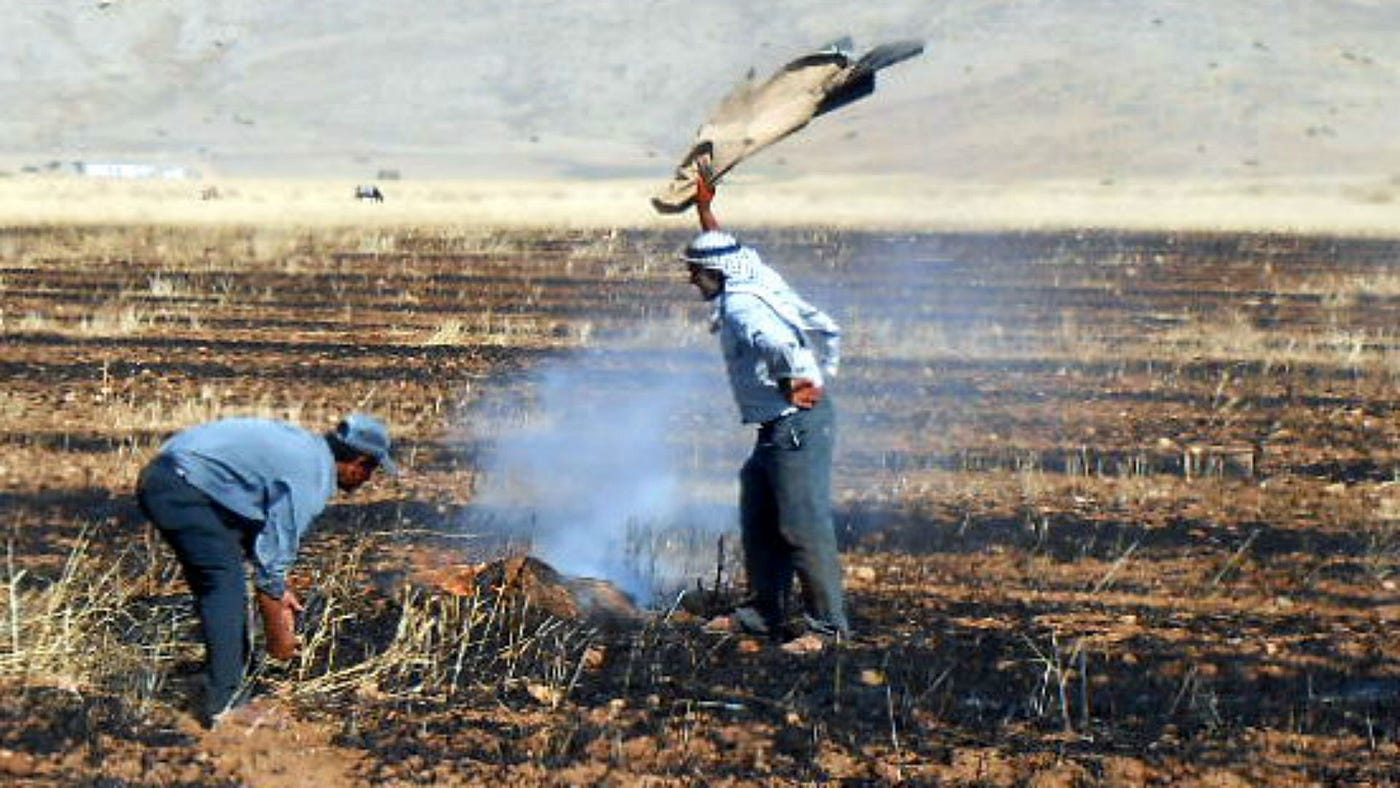
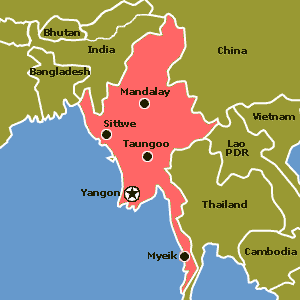
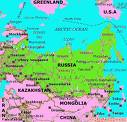
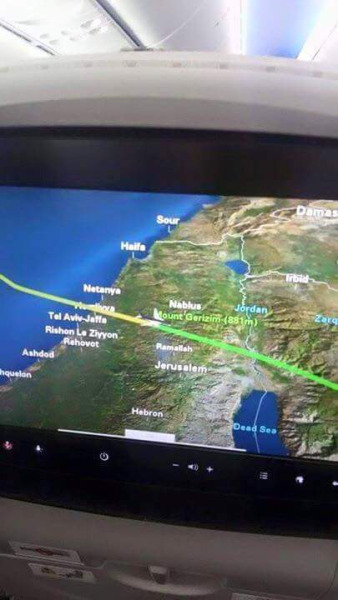
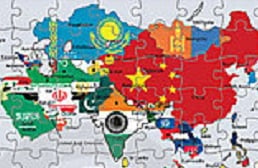

 Source:
Source:  Source:
Source:  Source:
Source: 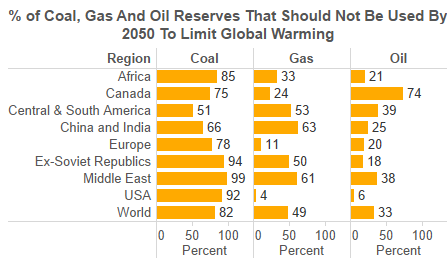 Source:
Source: 
